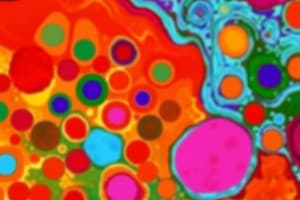Podcast
Questions and Answers
During haematopoiesis, what is the immediate fate of the daughter cell that does not remain in the bone marrow?
During haematopoiesis, what is the immediate fate of the daughter cell that does not remain in the bone marrow?
- It directly enters the circulating blood without further development.
- It immediately differentiates into a mature blood cell.
- It transforms into a hematopoietic stem cell (HSC).
- It undergoes several stages of development before becoming a mature blood cell. (correct)
A patient is diagnosed with acute myeloid leukemia (AML). At what stage of haematopoiesis did the malignancy most likely occur?
A patient is diagnosed with acute myeloid leukemia (AML). At what stage of haematopoiesis did the malignancy most likely occur?
- Differentiation of common lymphoid progenitors (CLPs).
- Differentiation of myeloid lineages. (correct)
- Maintenance of hematopoietic stem cells (HSCs).
- Maturation of erythrocytes.
Which of the following characteristics is related to Myeloproliferative disorders?
Which of the following characteristics is related to Myeloproliferative disorders?
- Overproduction of a single type of blood cell. (correct)
- Inhibition of fibroblast activity within bone marrow.
- Underproduction of all types of blood cells.
- Dysfunctional development of lymphoid cells.
In a lymph node, what is the primary interaction that occurs in the paracortex?
In a lymph node, what is the primary interaction that occurs in the paracortex?
Following activation in the lymph node, how do B and T cells exit to continue their immune functions?
Following activation in the lymph node, how do B and T cells exit to continue their immune functions?
Which of the following best describes the primary role of alveolar macrophages in lung immunity?
Which of the following best describes the primary role of alveolar macrophages in lung immunity?
How does the mucociliary surface contribute to lung immunity?
How does the mucociliary surface contribute to lung immunity?
What is the primary function of Peyer’s patches in gut-associated lymphoid tissue?
What is the primary function of Peyer’s patches in gut-associated lymphoid tissue?
A patient with inflammatory bowel disease (IBD) is likely to have which of the following?
A patient with inflammatory bowel disease (IBD) is likely to have which of the following?
Which of the following components of the innate immune system directly recognizes pathogens in the lungs?
Which of the following components of the innate immune system directly recognizes pathogens in the lungs?
Flashcards
Haematopoiesis
Haematopoiesis
Production of circulating blood cells, occurring in the bone marrow.
Leukemias
Leukemias
These malignant diseases disrupt normal blood cell production in the bone marrow, affecting lymphoid or myeloid cell lines.
Myeloproliferative disorders
Myeloproliferative disorders
Disorders with overproduction of blood cells or increased fibrosis in the bone marrow.
Lymph Node
Lymph Node
Signup and view all the flashcards
Lymph Node Cortex
Lymph Node Cortex
Signup and view all the flashcards
T cell role in B cell activation
T cell role in B cell activation
Signup and view all the flashcards
Gut-associated lymphoid tissues (GALT)
Gut-associated lymphoid tissues (GALT)
Signup and view all the flashcards
Epithelial Barrier Function
Epithelial Barrier Function
Signup and view all the flashcards
Mucociliary Clearance
Mucociliary Clearance
Signup and view all the flashcards
Alveolar Macrophages
Alveolar Macrophages
Signup and view all the flashcards
Study Notes
- Immunology
Haematopoiesis
- It is the site of circulating blood cell production in the bone marrow
Division of haematopoietic stem cells (HSC)
- One daughter cell remains in the bone marrow to renew the HSC pool; the other daughter cell matures into blood cells
Blood and Tissue Production in Bone Marrow
- Hematopoietic Stem Cells differentiate into: Multipotent Progenitors (MPPs), Common Lymphoid Progenitors (CLPs), and Common Myeloid Progenitors (CMPs)
Bone Marrow Disorders
- Leukemias are malignant diseases of the bone marrow that occur during haematopoietic development
- Lymphoid lineages develop into acute or chronic lymphoblastic leukemia (ALL/CLL).
- Myeloid lineages develop into acute or chronic myeloid leukemia (AML/CML)
- Myeloproliferative disorders are characterized by the overproduction of one type of blood cell, such as essential thrombocythaemia (platelets), polycythaemia vera (red blood cells), and myelofibrosis (fibroblasts).
- Myelodysplastic syndromes (MDS) are a spectrum of disorders involving the overproduction of one or more types of blood cells
- Multiple myeloma and Aplastic anemia are examples of MDS.
Lymph Node
- Activation of T and B cells occurs here
- The lymph node is connected to lymphatic and blood vessels
Lymph Node Structure
- The cortex (outer layer) of the node contains B-cell areas (follicles).
- The paracortex (middle layer) contains T cells and dendritic cells.
- Lymph vessels enter the nodes at the outer edge
- B and T cells leave the node via 'efferent' lymphatic vessels in the central 'medullary' region
- This important in pathogen responses occurs in the lymph node
- Dendritic cells present pathogenic peptides to T cells here
- T cell activation and differentiation happens at the lymph node
- Some T cells promote B cell activation in the lymph node
Immunity in the Gut
- Large intestine (colon) has 10^12 microorganisms per gram of luminal content
- There is a constant threat of potential pathogens
- Pathogens enter via intestinal mucosa
- Gut-associated lymphoid tissues are organized in Peyer's patches and mesenteric lymph nodes.
- Mucosal epithelium involves T cells, plasma cells, mast cells, dendritic cells, and macrophages
- Here, the epithelium has a barrier function
- Defects in barrier function can lead to the development and perpetuation of inflammation in inflammatory bowel disease (IBD)
Immunity in the Lungs
- The nasopharynx and tonsillar regions clear debris by inertial force (coughing and sneezing)
- The mucociliary surface captures and expels substances via upper airways
- Antimicrobial compounds include collectins and surfactant proteins
- These are recognized by innate immune cells and the complement system
- They also include antimicrobial peptide secretions
- The alveoli are the terminal branches of the lungs, where most of the gaseous exchange occurs
- Alveolar macrophages carry out phagocytosis and recruitment of other immune cells
Studying That Suits You
Use AI to generate personalized quizzes and flashcards to suit your learning preferences.
Related Documents
Description
This lesson covers haematopoiesis, the production of blood cells in the bone marrow, and the division of haematopoietic stem cells (HSC). It also discusses blood and tissue production in the bone marrow and various bone marrow disorders such as leukemias and myeloproliferative disorders.




